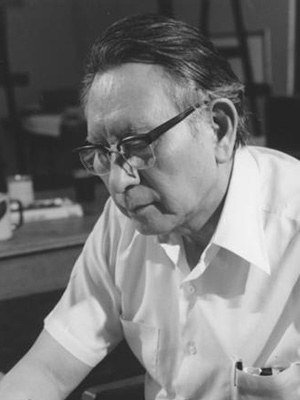Oscar Howe
Oscar Howe (1915–1983) was a renowned American Indian artist celebrated for his dynamic and modern interpretations of Dakota culture and mythology. Born on the Crow Creek Reservation in South Dakota, Howe was deeply rooted in the traditions of his people. From an early age, he drew inspiration from the rich visual language of Dakota art, including beadwork, quillwork, and storytelling.
Navigating the challenges of a predominantly white art world, Howe defied stereotypes and forged a path as one of the most innovative artists of his generation. Over time, he developed a distinctive style that fused traditional Dakota imagery with modernist abstraction. His work was marked by bold geometric forms, vivid colors, and expressive movement—elements that both honored his heritage and pushed the boundaries of contemporary Native art.
Throughout his prolific career, Howe produced a wide array of works including paintings, drawings, prints, murals, sculptures, and installations. His art was exhibited in major museums and galleries across the United States and Europe, earning him widespread recognition and numerous accolades. Despite facing persistent discrimination, Howe remained steadfast in his commitment to both artistic innovation and cultural integrity.
In 1948, he was appointed Artist-in-Residence at Dakota Wesleyan University in Mitchell, South Dakota, where he also earned his bachelor’s degree. He later received a Master of Fine Arts from the University of Oklahoma in 1954. Howe served as Director of Art at Pierre High School from 1953 to 1957 before joining the University of South Dakota in Vermillion as Assistant Professor of Fine Arts, Artist-in-Residence, and Assistant Director of the W.H. Over Museum. In 1971, the U.S. Department of State appointed him as a cultural lecturer to the Near East and South Asia, during which he presented programs in nine countries.
From 1948 to 1971, Howe also designed panels for the iconic Mitchell Corn Palace. During this period, he reconnected with longtime friend and fellow artist John “Leonard” Jennewein, a faculty member at Dakota Wesleyan University. Their renewed acquaintance during summers in Mitchell blossomed into a lasting friendship, further enriching Howe’s creative community.
Oscar Howe retired in 1980 and was named Professor Emeritus of Art at the University of South Dakota, a title he held until his death in 1983.
In 2022, a landmark exhibition titled Dakota Modern: The Art of Oscar Howe opened at the Smithsonian’s National Museum of the American Indian in New York. The exhibition brought renewed attention to Howe’s legacy, subsequently traveling to the Portland Art Museum in Oregon and the South Dakota Art Museum at South Dakota State University, where it was on view from June 10 to September 17, 2023.
